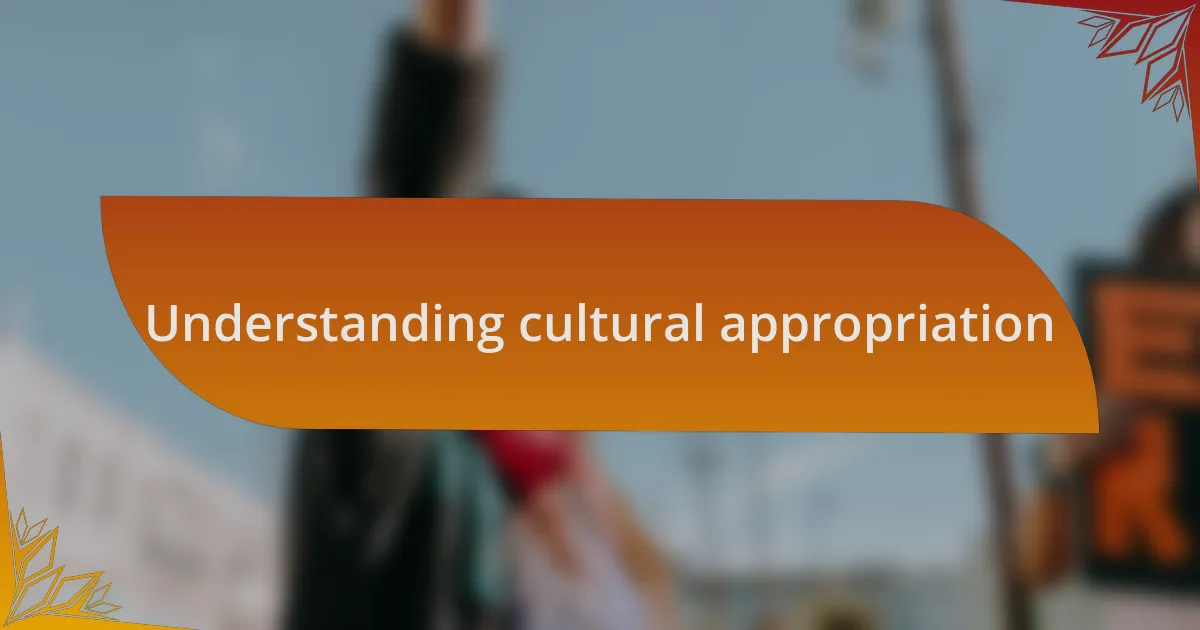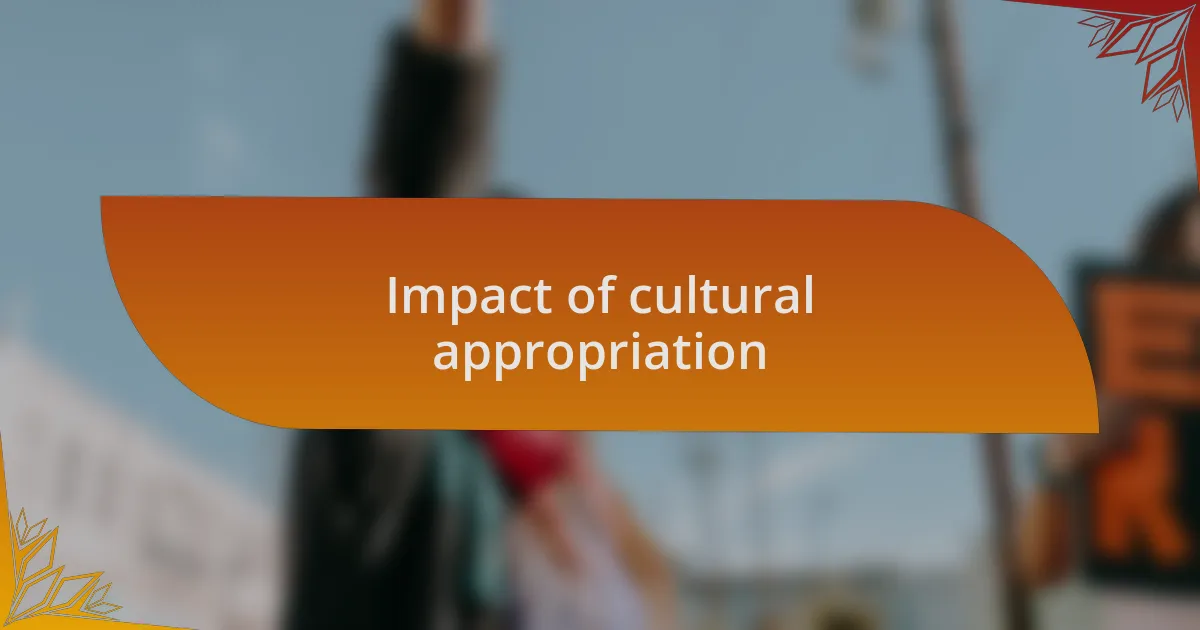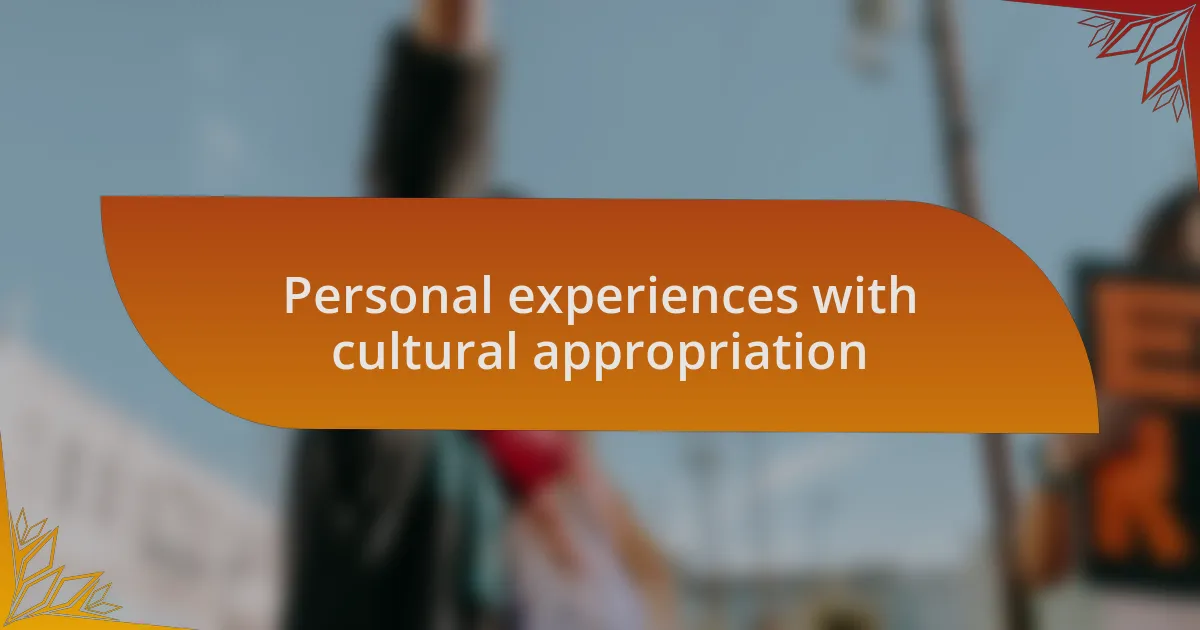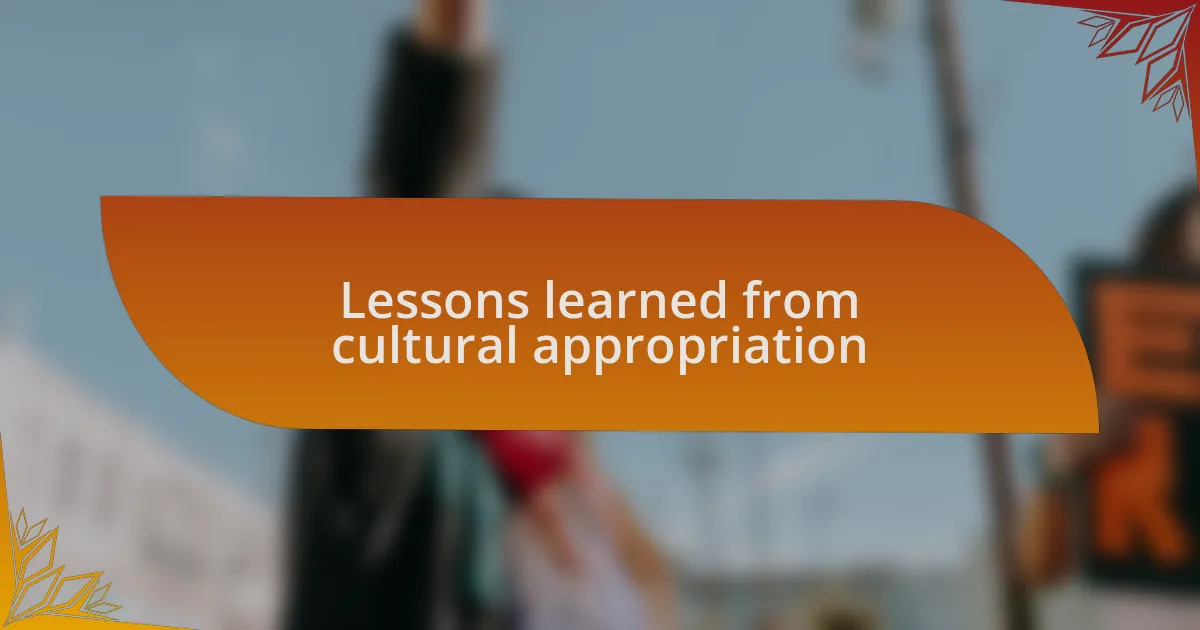Key takeaways:
- Cultural appropriation involves power dynamics where dominant cultures exploit marginalized cultures, often neglecting their significance.
- Appropriation can commodify culture, leading to the dilution of cultural identity and reinforcing stereotypes.
- Reparations politics seeks to address historical injustices and involves a complex discussion of acknowledgment and healing for affected communities.
- Intent and understanding are crucial in appreciating cultures, emphasizing the need for genuine respect rather than mere aesthetic admiration.

Understanding cultural appropriation
Cultural appropriation is often misunderstood as simply borrowing elements from one culture by another. However, it goes deeper than that—it involves power dynamics where the dominant culture takes from marginalized cultures without understanding or respecting their significance. I once saw a trendy café using Native American motifs in its décor, and it struck me as unsettling. Why were they celebrating aesthetics while overlooking the profound history behind those symbols?
As I explored this topic further, I realized that these appropriations often trivialize the experiences of those whose cultures are being borrowed from. I remember attending a fashion show where models donned traditional garments from various cultures without any context. It made me wonder: what’s the line between appreciation and appropriation? This isn’t just about aesthetics; it’s about acknowledging the stories and struggles behind cultural expressions.
Moreover, appropriation can lead to a commodification of culture, stripping it of its meaning and context. I once heard a friend mention how they love wearing a sari for Diwali celebrations without considering its cultural significance. It dawned on me then that many may not even realize how such actions can perpetuate stereotypes. How can we encourage a more informed conversation around this? Ultimately, it’s about recognizing the need for respect and understanding in our interactions with diverse cultures.

Impact of cultural appropriation
Cultural appropriation can inflict deep emotional wounds on communities whose traditions are exploited. I still remember attending a music festival where popular artists appropriated Indigenous sounds and attire without acknowledgment, leaving me feeling conflicted. Why did it seem more about profit than honoring a rich cultural tapestry? Such incidents can foster resentment and alienation among those whose heritage is reduced to mere trends.
On another occasion, I engaged in a conversation with a friend who wore a kimono to a party, proudly displaying it as a fashion statement. When I gently mentioned the garment’s significance in Japanese culture, I could see the realization wash over them. It made me think, how often do we pause to reflect on the origins of what we wear? This kind of interaction highlights a broader issue, as many people may unknowingly contribute to the erasure of the very cultures they admire.
The ripple effect of cultural appropriation extends beyond individual instances; it can dilute cultural identity and reinforcement of stereotypes. After witnessing how certain Black hairstyles, for instance, became trends in mainstream fashion while those who naturally have them face discrimination, I couldn’t help but feel a sense of injustice. Are we not responsible for ensuring that appreciation does not come at the expense of others? These reflections serve as a call to action for all of us to remain aware and respectful in our cultural engagements.

Overview of reparations politics
Reparations politics encompasses a multifaceted approach to addressing historical injustices and compensating communities harmed by systemic discrimination. I often find myself pondering the complexities of this issue as I witness debates unfold in various public spaces—are we truly ready to face the uncomfortable truths of our past? Conversations about reparations challenge us to consider not just financial restitution but also acknowledgment, healing, and the restoration of dignity for marginalized communities.
In my experience, public perception of reparations can be influenced by a blend of misinformation and deeply held beliefs. I recall a lively discussion at a community gathering where views clashed; some felt reparations were essential for justice, while others argued against the practicality of implementing such measures. It struck me how personal stories often shape our perspectives—people advocating for reparations often shared poignant ancestral experiences that transcended statistics, making the conversation more human and relatable.
Ultimately, the discourse surrounding reparations politics poses vital questions that reach beyond numbers and policy frameworks: What does justice truly look like in a society marked by unequal power dynamics? I believe that engaging in these conversations requires us to embrace vulnerability and openness, as we not only discuss the past but also envision the future we want to create together.

Relation between appropriation and reparations
Cultural appropriation and reparations interweave in a complex relationship, as both issues address systemic power imbalances. When I think about cultural appropriation, I often recall a time when I attended a festival celebrating diverse traditions. It was eye-opening to see how some borrowed cultural elements for fashion without acknowledging their origins, prompting a larger conversation about respect versus exploitation. This scenario serves as a reminder that borrowing without giving due credit can perpetuate historical injustices, calling for a deeper discussion on reparations.
Reparations seek to redress harms done to communities, while appropriation often highlights how those very communities continue to be marginalized. I’ve had moments where I felt anger and frustration over the appropriation of sacred cultural symbols by those removed from their original context. It makes me wonder: how can we foster genuine appreciation instead of appropriation? If society can recognize the harms of appropriation, it might be more willing to engage in reparative measures, reinforcing the idea that respect for culture should be foundational to any reparative discussions.
Moreover, I believe that true reparations involve understanding the pain associated with cultural theft. Reflecting on conversations about identity and belonging, I often find myself advocating for a shared responsibility among all individuals to appreciate the rich histories behind cultural expressions. In this light, reparations can act as a step towards honoring and restoring what has been taken, illuminating the path towards healing and understanding.

Personal experiences with cultural appropriation
I remember visiting a popular coffee shop where the barista wore a kimono-like attire, which I initially found beautiful. However, my admiration quickly shifted to discomfort as I learned that the barista had no ties to the culture it represented. This incident led me to question: how can we embrace beauty without understanding its roots? It felt like a moment where appreciation lost its authenticity, and that stuck with me.
During a local art exhibit, I was jolted by sculptures that mimicked traditional indigenous designs but lacked any connection to the communities they mimicked. I felt a sense of betrayal as I saw those artworks celebrated without acknowledgment of their origins. This experience underscored for me the importance of understanding the stories behind cultural expressions rather than just appreciating their aesthetic value; isn’t it our responsibility to ask where these meanings come from?
On a more personal level, I recall wearing a cultural symbol I cherished, only to find out later that it held deep spiritual significance to another group. My heart sank, realizing I had unknowingly contributed to its appropriation. This taught me a vital lesson: engaging with cultures requires sensitivity and a genuine interest in their narratives. How can we learn to honor rather than exploit? That question has become a guiding principle for me in navigating my interactions with diverse cultures.

Lessons learned from cultural appropriation
Reflecting on the topic, one significant lesson I’ve learned from cultural appropriation is the value of intent. I recall a friend who proudly adopted a hairstyle traditionally worn in a specific culture, believing it to be a tribute. It was a bittersweet moment when I pointed out that intent doesn’t always equate to respect. It made me realize that understanding the cultural significance behind practices is essential for genuine appreciation; how can we claim to honor a culture if we don’t bother to learn its history?
Another lesson that stands out to me is the importance of listening. I once attended a panel discussion where a member from a marginalized culture spoke about the pain of seeing their heritage commodified. Their heartfelt narrative opened my eyes to the real-life impact of appropriation. It posed a troubling question: in a world so rich with diversity, why do we often prioritize our narratives over others? Listening can be a powerful way to bridge the gap between cultures, fostering deeper connections instead of superficial interactions.
Lastly, I’ve come to understand the role of community in cultural expression. I was part of a workshop led by artists from a particular cultural background, and their process of sharing was deeply informative. They emphasized that cultural symbols belong to communities and that respecting these boundaries is crucial. I couldn’t help but ask myself: how can societal advancement happen without acknowledging the cultural fabric that supports it? This experience has taught me that recognizing and respecting these boundaries is key to fostering a more inclusive environment.

Future steps in reparations advocacy
In advocating for reparations, I believe a vital future step involves creating spaces for dialogue that include diverse voices, especially those historically marginalized. For instance, I participated in a community gathering where individuals shared their experiences related to historical injustices. Hearing their stories not only deepened my understanding but also highlighted the importance of centering those directly impacted in discussions about what reparations should look like. Why do we often sideline these voices?
Additionally, incorporating educational initiatives that inform the public about the systemic inequalities tied to reparations is crucial. I remember when I attended a workshop aimed at educating local leaders about the concepts surrounding reparations. The participants’ reactions were illuminating; many had never considered the historical context of their policies. Providing engaging and accurate information can spark necessary conversations and motivate individuals to advocate for policy changes. What if we all dedicated time to understanding the history that shapes our present?
Finally, forming coalitions among various organizations can significantly amplify the reparations movement’s impact. I recently witnessed a collaborative event between different advocacy groups, and the collective spark of energy was palpable. It dawned on me that while each group has its unique focus, united efforts can push for broader systemic reforms. Isn’t it empowering to think that together we can create a change that resonates beyond our separate missions?